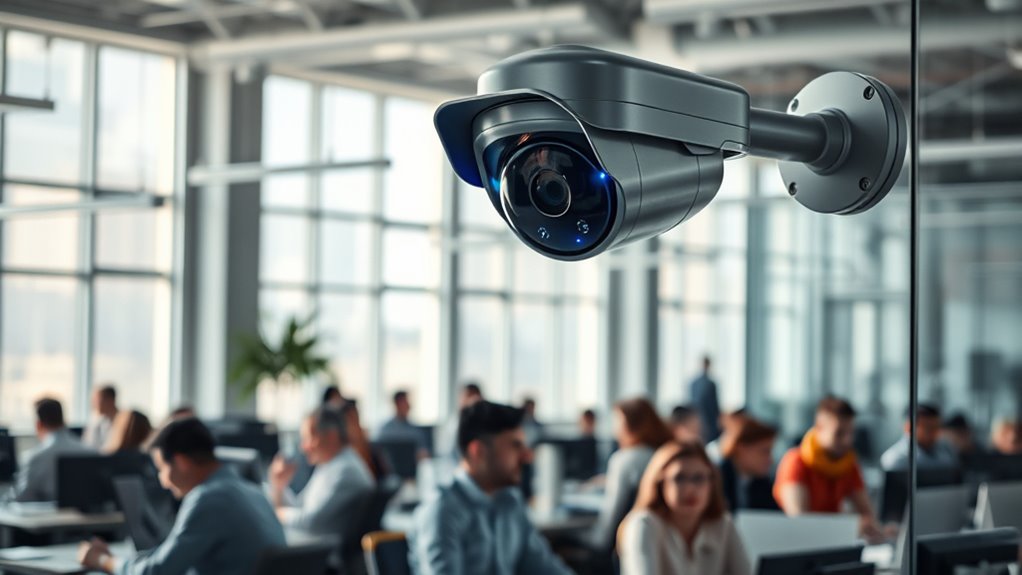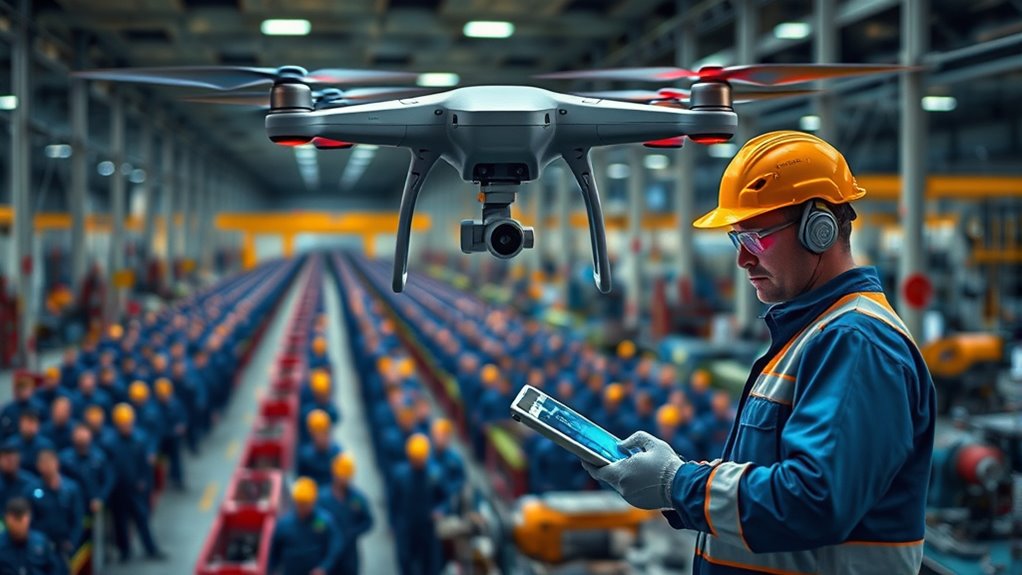AI in the workplace can act as a Big Brother, invading your privacy with constant monitoring or as a helpful assistant that boosts productivity and safety. While surveillance tools analyze data to improve security and provide insights, they also raise concerns about invasion of privacy and trust. Striking the right balance is key, and understanding how organizations implement these systems can help you see whether AI is there to support or supervise. Explore further to discover how to navigate this evolving landscape.
Key Takeaways
- AI can enhance productivity and security, acting as a helpful tool when transparency and ethical use are prioritized.
- Excessive surveillance may invade privacy, cause stress, and reduce employee satisfaction, shifting AI from helper to Big Brother.
- Clear policies, consent, and privacy safeguards are essential to balance AI’s assistance with respect for personal boundaries.
- AI-driven insights support employee development and fair evaluations, promoting trust and collaboration in the workplace.
- The perception of AI as a helper or surveillance depends on transparency, ethical governance, and employees’ involvement in monitoring practices.
The Rise of AI in Workplace Monitoring

The rise of AI in workplace monitoring is transforming how companies oversee employee performance and behavior. AI-driven tools analyze historical data to predict patterns, enabling management to take proactive steps. They also bolster security by flagging unusual activity, helping prevent data breaches and ensuring regulatory compliance. Additionally, AI offers personalized insights, suggesting ways to optimize work habits and boost productivity. Automated analysis reduces subjective biases, leading to fairer evaluations. As AI becomes more sophisticated, it integrates seamlessly into workflows, making monitoring less intrusive and more effective. The integration of AI with existing systems ensures smoother implementation and enhances overall efficiency. Over 67% of US companies now adopt AI in their operations, with many believing it will surpass traditional methods soon. This evolution reflects a shift toward smarter, more efficient workplace oversight driven by AI technology. AI’s ability to automate cognitive functions is also enabling real-time feedback and continuous improvement in employee performance.
Employee Perspectives on Surveillance and Privacy

Have you ever wondered how employees really feel about workplace surveillance? Many workers feel uncertain about what’s being monitored. Confidence in understanding monitoring practices dropped from early to late 2020, with nearly one-third feeling less sure about what their employers track. Employees in education and health sectors are especially unsure. Women are more likely than men to report decreased understanding. Over half experience anxiety about being watched, and 43% see monitoring as an invasion of privacy. Many feel surveillance adds stress and lowers job satisfaction, with about half considering quitting if monitoring increases. Despite employers believing monitoring boosts productivity, most employees disagree. Privacy concerns foster distrust, leading workers to take countermeasures like faking activity or using anti-tracking tools, reflecting dissatisfaction and resistance. Additionally, by 2025, employee monitoring has become a dominant practice across workplaces, with 70% of large companies implementing such systems, indicating widespread acceptance of surveillance technologies. As awareness of surveillance and privacy issues grows, employees are increasingly seeking ways to protect their personal information at work. The rise of home office setups has further blurred the lines between personal and professional privacy, complicating these issues. Furthermore, understanding employee privacy rights can empower workers to advocate for fair monitoring policies and protections. Recognizing how sound healing science can influence workplace stress management might offer employees alternative coping mechanisms amidst surveillance concerns. Moreover, ongoing discussions about ethical surveillance emphasize the importance of balancing security and individual freedoms in the digital age.
Balancing Productivity and Well-being

Balancing productivity and well-being in workplaces with AI surveillance presents a complex challenge. While AI tools can boost performance insights and personalize feedback, they can also cause employee dissatisfaction and resistance, especially when monitoring feels intrusive. You might notice that constant oversight leads workers to engage in counterproductive behaviors, like fidgeting or “mouse jiggling,” to avoid suspicion. High-pressure environments can increase workplace injuries and reduce morale. However, when AI is used for developmental feedback rather than surveillance, employees tend to respond more positively. Building a high-trust culture is key—transparent communication and involving employees in AI implementation can ease resistance. Understanding the importance of employee perceptions and addressing privacy concerns can significantly impact acceptance. Additionally, leveraging real-time monitoring capabilities can help organizations respond promptly to potential issues, fostering a safer work environment. An awareness of privacy considerations and how they influence employee attitudes is essential for successful integration. Promoting ethical AI practices can help balance organizational goals with respect for individual rights. Incorporating organizational transparency can further enhance trust and reduce apprehension among staff. Striking this balance requires thoughtful integration of AI’s benefits with a focus on maintaining employee well-being and fostering a supportive environment. AI adoption is most effective when it prioritizes enhancing employee trust and engagement rather than solely monitoring performance.
Ethical Dilemmas in AI Surveillance

You might feel uneasy about how AI surveillance blurs the line between transparency and privacy, especially when monitoring extends into personal spaces. It’s essential that organizations clearly communicate what data they collect, how it’s used, and obtain your informed consent. Without respecting your autonomy, surveillance risks eroding trust and raising serious ethical questions. Data Bias can also lead to unfair treatment or misjudgments, further complicating the ethical landscape of AI monitoring. Implementing privacy controls can help balance security needs with individual rights. Embracing creative practice in developing ethical AI solutions can foster innovative approaches to addressing these challenges. Additionally, understanding market trends in AI deployment can inform ethical decision-making and responsible implementation strategies. Recognizing user trust as a crucial element is vital for fostering positive relationships between organizations and individuals when utilizing surveillance technologies. Furthermore, ongoing AI Security research is key to identifying vulnerabilities and ensuring that surveillance systems are both effective and ethically sound.
Privacy vs. Transparency
As AI surveillance becomes more common in workplaces, a key ethical dilemma emerges: how to guarantee transparency while respecting employees’ right to privacy. You need clear communication about when and how AI tools are used, but balancing this with privacy concerns isn’t easy. Transparency can build trust, yet many employees still worry about constant monitoring invading their personal space. Most Americans oppose AI for tracking workers’ movements and desk time, highlighting widespread privacy apprehensions. Openly sharing surveillance practices reassures staff. AI tools track work, but sometimes blur personal boundaries. Awareness of monitoring increases employee unease. Implementing privacy safeguards can help mitigate these concerns while maintaining necessary oversight. Sophisticated AI can analyze speech and behavior, raising privacy fears. Regulations are needed to assure fair, transparent use. Striking this balance is vital to avoid alienation and maintain a healthy work environment. Without transparency, trust erodes, but respecting privacy remains essential for ethical AI deployment.
2. Consent and Autonomy
Consent and autonomy are fundamental ethical considerations in AI surveillance, ensuring employees are informed about what data is collected and how it’s used. You should be aware that transparent communication and clear policies are essential for building trust. When organizations obtain written consent, they respect your right to choose whether to participate. AI surveillance can impact your perceived autonomy by monitoring your every move, which may feel invasive or unfair. To maintain morale and engagement, companies need to balance monitoring with respect for your rights. Ethical governance and ongoing stakeholder dialogue help prevent misuse and bias. Additionally, understanding the horsepower of electric dirt bikes can shed light on how power and performance metrics might influence perceptions of control in AI systems. Recognizing the environmental impacts of data centers is also crucial, as the energy consumption associated with AI infrastructure can be significant. As AI continues to evolve, ongoing regulatory frameworks are necessary to ensure ethical standards are upheld. The development of privacy-preserving techniques such as data anonymization can further enhance trust in AI applications. Ultimately, when AI use is transparent and consensual, it supports both organizational goals and your autonomy, fostering a fair, trustworthy workplace environment. Understanding the importance of employee privacy can help organizations develop more ethical AI practices.
Technological Advances and Future Trends

Technological advances in AI are rapidly transforming workplace dynamics, with most companies investing heavily in AI integration despite only a small percentage feeling confident about their maturity levels. You’ll see AI evolving in areas like workforce management, safety, and surveillance. Future trends suggest you’ll encounter:
- Increased AI maturity, leading to smoother integration
- Broader use of online and physical space monitoring
- Enhanced safety analytics reducing incidents further
- Growing focus on privacy regulations like GDPR
- AI offering personalized feedback and predictive insights
- The development of continuous learning models that adapt to changing threats and operational environments. These models will enable AI systems to better respond to new challenges, much like how Halloween traditions evolve each year to reflect current trends and cultural shifts. As AI becomes more sophisticated, ethical considerations will become increasingly important to ensure responsible deployment and maintain public trust. Additionally, ongoing research into machine learning techniques will further improve AI adaptability and resilience in dynamic environments. For instance, integrating zodiac compatibility insights can help tailor AI interactions to diverse user preferences, enhancing user experience. These trends indicate AI will become more embedded in your daily work, balancing efficiency with privacy concerns. As AI advances, your organization will likely improve safety and performance, but it will also need to navigate ethical and regulatory challenges to maintain trust and transparency.
Strategies for Building Trust and Transparency

Building trust starts with clear communication policies that explain what data is collected and why. Protecting employee privacy through transparent monitoring practices shows you respect their rights and fosters confidence. By openly sharing information and listening to concerns, you create a workplace where AI surveillance feels fair and accountable.
Clear Communication Policies
Effective communication policies are essential for fostering trust and transparency around AI use in the workplace. They should clearly state what data AI collects, how it’s processed, and the reasons for monitoring or assistance. Be specific about the types of tools used, such as productivity trackers or security checks, to avoid confusion. Regular notifications about ongoing data collection help keep employees informed and reduce suspicion. It’s important to clarify boundaries between work-related monitoring and personal activities to address ethical concerns. Accessible documentation and updates ensure everyone understands any policy changes. To keep engagement high, consider:
- Explaining AI’s purpose, like safety or productivity
- Outlining data collection methods
- Notifying employees regularly
- Clarifying boundaries between work and personal data
- Providing updates and documentation
Employee Privacy Protections
To foster trust and transparency around AI surveillance in the workplace, implementing strong employee privacy protections is essential. Start by classifying employee data based on sensitivity to determine appropriate safeguards. Maintain secure recordkeeping policies and enforce access controls to prevent unauthorized data access. Guarantee compliance with data protection laws and regulations to avoid legal issues, and have incident response plans ready to address data breaches swiftly. Develop exhaustive privacy policies that clearly outline data collection, use, and security measures, and regularly update them to reflect new laws and technology changes. Provide training to employees on their privacy rights and responsibilities, involving HR in policy development. By prioritizing these measures, you demonstrate respect for employee privacy, building trust and a positive workplace culture.
Transparent Monitoring Practices
Transparent monitoring practices are essential for fostering trust and openness in the workplace. When you clearly communicate your intentions, employees understand how monitoring benefits everyone. Be upfront about the purpose and scope, avoiding vague language that causes confusion. Explain how data supports productivity, safety, or compliance, not punishment. Share details on what activities are monitored and how often. Keep employees informed about any policy changes promptly.
To build trust, consider these strategies:
- Disclose monitoring goals and practices before implementation
- Seek employee input during system design and deployment
- Provide channels for concerns and questions
- Share summaries or reports on data use regularly
- Ensure data protection measures meet legal standards like GDPR
Adopting these approaches shows your commitment to transparency, fostering a culture of collaboration and trust.
Navigating the Shift Toward Automated Assistance

As workplaces increasingly adopt AI-powered tools, guiding this shift requires careful balance and strategic planning. You need to understand that 62% of employees aged 35-44 already have high AI expertise, and 70% of leaders believe AI automation will surpass traditional automation within three years. Recognize that around 25% of work tasks could be handled by AI, boosting efficiency and freeing up human resources. However, be aware that 300 million jobs worldwide may be lost to AI, with 60% of jobs in advanced economies at risk. To navigate this transition, focus on retraining workers, integrating AI thoughtfully, and leveraging its strengths to augment productivity. A proactive approach guarantees you maximize AI benefits while minimizing disruption and job displacement.
Frequently Asked Questions
How Can Companies Measure the Effectiveness of AI Surveillance?
You can measure AI surveillance effectiveness by tracking key performance metrics like accuracy, precision, recall, and F1 score, which help you evaluate system reliability. Regularly monitor these metrics to identify false alarms and improve detection. Use real-time analysis and advanced search capabilities to assess how well the system detects threats. Consistently review object recognition and performance data to guarantee your AI system stays accurate and efficient.
What Legal Regulations Govern AI Monitoring in Workplaces?
Imagine your company uses AI to monitor productivity, but you’re unsure of the rules. Currently, laws vary by state; for example, Colorado’s CAIA regulates algorithmic bias and requires transparency, while California’s CPRA emphasizes employee data privacy. You must follow these regulations, conduct impact assessments, and disclose AI use. Although there’s no federal law yet, staying compliant with state laws guarantees your monitoring practices respect employee rights and reduce legal risks.
How Do AI Tools Impact Employee Creativity and Innovation?
AI tools boost your creativity and innovation by automating routine tasks, freeing you to focus on complex, inventive work. They help narrow skill gaps and encourage skill crafting, which enhances your problem-solving abilities. When used correctly, AI inspires you to explore new ideas and collaborate more effectively. Leadership that supports and understands AI’s capabilities amplifies these benefits, making innovation more accessible and fostering a more dynamic, creative work environment.
What Training Is Needed for Employees to Adapt to AI Assistance?
To adapt to AI assistance, you need targeted training that covers technical skills like understanding AI tools and data security. You should also learn about AI ethics and privacy laws to guarantee responsible use. Practical, real-world scenarios and blended learning methods make training effective. Embrace continuous learning, experiment, and stay updated on technological advances to confidently integrate AI into your workflow.
How Can Organizations Ensure AI Ethics Are Upheld in Monitoring Practices?
To guarantee AI ethics are upheld in monitoring practices, you should implement regular audits to check for bias and fairness. Communicate transparently with employees about data collection and obtain their consent. Respect privacy by monitoring only necessary activities and providing granular control options. Align your practices with legal standards like GDPR, and develop clear policies to foster trust and accountability, ensuring your AI usage remains ethical and responsible.
Conclusion
As AI becomes your workplace’s silent partner, it’s up to you to steer this evolving ship with trust and transparency. Think of AI as a guiding lighthouse—illuminating the path to productivity while guarding your privacy’s shores. Embrace the balance, and you’ll find it’s not about big brother watching over you, but about big helper lending a hand. Together, you can shape a future where technology empowers rather than intrudes.









